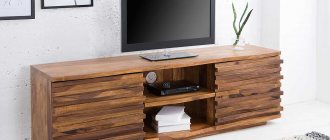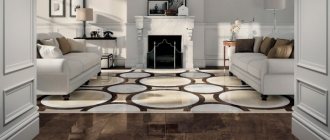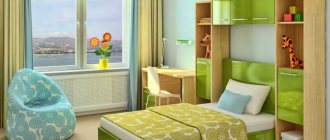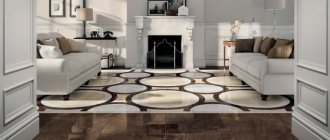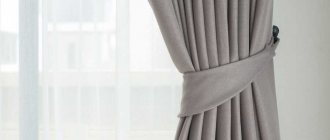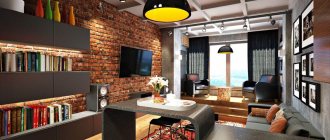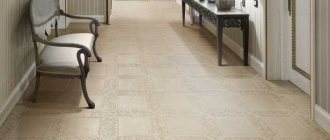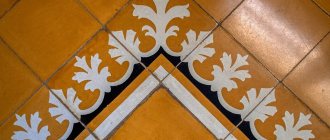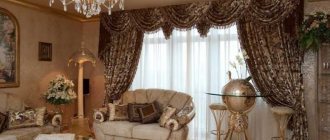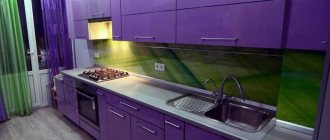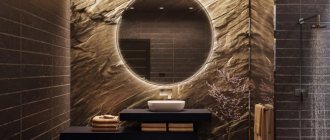Features and advantages of mirror tiles in the interior
Tiles with a mirror surface are an original finishing solution. This material is able to visually increase the area of a room, mask repair flaws and stylishly decorate walls in standard apartments or private houses.
The tiled surface has almost one hundred percent reflective ability. It is resistant to mechanical stress, shock, high temperatures, moisture or chemical reagents.
Mirror tiles look beautiful and interesting. Thanks to the variety of colors and configuration types, you can create a variety of images from this decorative material. These decorative parts are easy to install. Even a non-professional can handle its installation. But over time, black spots appear on this material, as well as stains if the surface is washed not with special cleaning agents, but with water.
Bedroom design with mirror surfaces
If you want to transform a small bedroom, it is best to use a mirror panel. It is best to install it opposite a window. The room will appear bright and spacious.
If the room has niches and uneven walls, be sure to stick mirror tiles in them. The result will be very original.
But in everything you need to know when to stop. You cannot glue mirror tiles randomly throughout the room. You risk getting an uncomfortable and cold room that looks more like a dance hall. Remember, mirrors in the bedroom play the role of an additional design, not the main one.
If you are a person prone to all sorts of superstitions, then mirrors in the bedroom should not be installed in the following way:
- You cannot install a mirror design opposite the bed. During sleep, a person gets rid of all the negativity accumulated during the day, and the mirror will return it back. And if a married couple sleeps in front of the mirror, then a quick breakdown in their relationship awaits them.
- It is not recommended to install mirror surfaces opposite the entrance door to the bedroom. Thus, favorable energy will not flow into the room.
- In the mirror installed in the bedroom, a person should be reflected in full height. If for some reason this cannot be done, then the reflection should be logical.
To decorate your bedroom with mirror panels, use the following tricks:
- decorate the bottom perimeter of the room with mirror fragments of coal;
- to increase the height of the room, make a mirror panel on the ceiling;
- You can decorate the head of the bed with mirrors, this will add depth to the room;
- install symmetrically two tall mirrors from floor to ceiling in the area of the bedside tables;
- for the bedroom it is better to choose round or oval mirror elements;
- install a backlight near the mirror surface or hang a garland.
Related article: How to make a vibrating table for paving slabs with your own hands
Types and types of tiles
There are many types of tiles that are used in different interiors. Depending on its type, the installation of this decorative material differs. Smooth tiles without relief are laid in such a way that their joints are invisible. This allows you to make real mirror canvases from it, which look impressive in minimalism and hi-tech styles.
Beveled tiles help create complex surfaces for palace and classical interiors.
Bevel - beveled edge of mirror glass
Tiles with an imitation metal surface (bronze, silver, gold) are suitable for all styles. Material with a regular or textured pattern (texture) gives the interior individuality and expressiveness. Tinted mirror tiles are distinguished by different shades of glass or amalgam surface: smoky gray, white, pink. Mirror mosaic will fit into Art Deco and Art Nouveau styles.
Mirror tiles are also classified according to their shape; the most common options are: square, triangular, rectangular, hexagonal (honeycomb).
Mosaic design
Modern mosaic is represented by a wide range. Types of mirror tiles differ in the type of processing, shape, shades and size.
- The edges of products are processed in different ways: the surface can be ground or polished. A bevel is also used, which gives the tiles additional volume.
- On sale there are not only square-shaped products, but also in the form of rhombuses, rectangles, and hexagonal honeycombs. Round tiles are particularly original.
- To diversify the usual “silver” mirror shade, manufacturers have learned to tint products to look like black mirror, bronze and gold.
The photo shows a bathroom in which the space is uniquely expanded due to combined mirror parts of different sizes.
The mosaic also differs in its size: from small (10x10 mm) to large (several centimeters in area).
This cladding consists of many individual fragments or tissers, which can be large or small and have a wide variety of shapes, for example round, rectangular, in the form of squares, diamonds or honeycombs.
The photo shows a mosaic in the form of hexagons in the design of an apron in the interior of a modern kitchen.
Square tissers are most often laid in strict parallel rows and columns to form clear lines on the surface. Rectangular fragments, due to their unusual placement, allow you to achieve unique combinations. Round mosaics significantly soften the design and can be the same or different sizes. Figured elements allow you to create specific patterns or, conversely, unusual chaotic decoration.
The photo shows a bedroom interior with a large white mosaic on the wall.
READ MORE: Do-it-yourself vices of the main types of metalworking carpentry manufacturing and drawings
Thanks to different design options, it is possible to bring any creative ideas to life and create an undeniably beautiful interior.
Thanks to such a highly artistic element, which represents a real picture, it is possible to favorably emphasize the aesthetic appearance of the room and create a bright visual accent in it.
Mirror
It has a unique reflective ability, due to which the room visually becomes larger, more spacious and much lighter.
Moroccan
Complex, mathematically verified Arabic patterns, distinguished by a huge number of elements, strict symmetry and combination of colors, will create a truly majestic atmosphere of oriental palaces in the room.
It involves inserting and decorating only certain areas, such as columns, bookshelves and mantelpieces, corners, various recesses, areas around mirrors or only half a wall, which allows you to magically transform the interior space.
Production and technical specifications
Due to their structural features, mirror tiles are produced differently from ordinary ceramic tiles. In production, large canvases are first taken, which are automatically cut into individual segments of the desired shape and size.
The mirror surface itself is made using the damping method. Special crystalline substances are added to the molten glass, which subsequently give the tile surface a characteristic shine.
After cutting, the material is ground and polished, carefully processing the edges. But sometimes this decorative element is made of polystyrene. In this case, it can be easily cut, painted, or even embossed designs can be created on its surface. But this material is not environmentally friendly, and designs on the reflective surface are made using sandblasting.
The distinctive technical properties of mirror tiles include moisture resistance and environmental friendliness.
Bathroom
In the interior of bathrooms and toilets, mirror elements can look very impressive. These are those rooms in which almost the entire surface of the walls can be lined with it. The only inconvenience is that when using hot water, the tiles fog up.
Passage areas
A corridor, a passage from room to room, or a staircase in a house are not the most illuminated places, so a mirror surface, especially with proper lighting, would be very appropriate. The original option is to decorate the risers with tiles. In this case, the steps seem to be floating in the air, and the staircase itself is very light.
Interior decoration
Mirror tiles can be used in almost any interior. It is convenient to apply to a wide variety of materials: plastic, metal, ceramics, etc. But when using this decorative element you need to know a sense of proportion. A large number of mirrors and stained glass windows in a room negatively affect a person’s psychological state.
You can use mirror tiles only on two adjacent surfaces, for example, on the ceiling and one of the walls, but in this case it is better to take materials with different textures or patterns. It is not worth covering the ceiling completely with mirrors, because... It may feel like the room is upside down. It is more expedient to decorate only part of the ceiling with this material.
To ensure that the light reflected on the surface of the mirrors does not tire the eyes of the beholder, it is better to use lamps with a soft matte glow or LEDs.
You can use mirror tiles in any room of an apartment or private house.
4.1 Hallway interior
Reflective surfaces allow you to visually enlarge a small hallway and harmoniously decorate a large hall. If the apartment has a narrow, long corridor, then there is no need to decorate both walls with mirrors at once; you should limit yourself to only one plane.
In small hallways, you can line part of the wall with this material and hang lampshades above them. This will make the corridor visually more spacious and comfortable.
In the halls, mosaic tiles look great, effectively decorating one of the walls. Mirrors also look good in a hallway niche. A wardrobe is usually placed in it, but if there is no need to install it, this niche can be decorated with mirror tiles with ornaments or bright designs.
The tiles often depict:
- hieroglyphs;
- silhouettes of people, animals and birds;
- flowers;
- eastern ligature.
4.2 Living room design
Mirror tiles in the living room are often used to zone the room. Often it is used to highlight a fireplace or a sofa. In private homes, columns and niches are decorated with this material. The fireplace framed by a mirror mosaic looks very impressive. You can also make a stripe on the wall from this tile, placing flowers or floor lamps next to it. Thanks to this technique, it will seem that there is a lot of color and light in the living room.
This material is also used to decorate furniture. They can be used to lay out wall shelves or shelving facades. Moreover, mirror tiles will be appropriate in palace, urban, and oriental interiors.
A mosaic of mirrors is suitable for a kitsch-style interior, creating unusual multi-colored tints. You can decorate one of the living room walls with classic tiles, and then place a stylish sofa next to it. Its straight lines will look good against a mirror background.
4.3 Kitchen decoration
Mirror tiles in a post-Soviet kitchen look unexpected, although acceptable. This decorative item is not only beautiful, but also functional. It is ideal for classic small kitchens in typical homes. Mirror tiles can be used to decorate the kitchen apron. This tile can be decorated with interesting designs, ornaments or holography.
For kitchen sets in a classic style, aged mirror tiles are suitable. On such a surface, stains, drops of water and fat are almost invisible. This decorative material can be used to decorate the wall above the kitchen unit if there are no top drawers, or the wall next to which the dining group is located. This technique will help give a narrow and long kitchen a square shape. And, of course, you can decorate the facade of the kitchen unit with mirror tiles.
4.4 Bedroom design options
Mirror tiles in the bedroom make the room unusual and piquant. From this material you can make a completely monolithic wall or a mirror ceiling. But such an installation should not be placed directly opposite the window; the tiles will look much more impressive to the left or right of it.
If a wall decorated with mirror tiles reflects sources of artificial light, this can make the room brighter and more comfortable. But this finishing method is only suitable for large rooms. In small bedrooms, it would be more appropriate to decorate only part of the wall with mirror tiles, for example, the head of the bed.
The doors of wardrobes, bedside tables or chests of drawers for linen are often decorated with tiles, and beds are also decorated with mirror tiles, but this will not be appropriate in all interior styles.
4.5 In the children's room
The presence of a mirror wall in a children's room causes controversy among designers and psychologists. Of course, such tiles will look impressive and stylish, turning the nursery into a fairy-tale corner, but from a psychological point of view, this piece of furniture is inappropriate in rooms for small children.
A wall made of mirror mosaic can disrupt a child’s sense of reality, so this interior element is suitable only in rooms for teenagers. In other cases, you can hang a panel of mirror tiles on the wall or decorate the clock in the room with tiles. But such decor is not recommended to be placed in front of the child’s eyes: above the desk, opposite the bed or in the sports area next to the wall bars. Mirror tiles are best placed in places where sunlight and light from lamps, floor lamps or ceiling chandeliers fall.
4.6 Bathroom
Mirror tiles are appropriate in any bathroom. One of the walls of the bathroom can be made completely mirrored: from regular or mosaic tiles.
This finishing method looks beautiful and is one of the most practical. A wall of mirrors opposite a window or bathtub looks especially impressive. This makes the bathroom light, bright and airy.
Mirror tiles do not deteriorate from moisture and are practically resistant to its effects. You can use it to lay out the ceiling or part of it, giving the interior a romantic style. When decorating a bathroom, some people combine ceramic and mirror tiles, and spectacular shiny inserts appear in ordinary white tiled walls.
This material can be used to decorate the facade of bathroom furniture. But there is no need to make the bathroom completely mirrored, decorating the ceiling, walls, and furniture with these tiles. This can make the bathroom cold and uncomfortable, even if warm colors are used in the interior.
Living room design with mirrored walls or ceiling
Decorating a living room with mirrors depends on the size of the room. If the room is small, then it is better to decorate not the entire wall with mirrors, but only the cabinet doors. Thus, large and bulky furniture turns into an inconspicuous piece of furniture.
It is allowed to design one small wall with mirror tiles. The joint must be decorated with plaster molding. Thanks to this, the decoration seems complete and laconic.
If you are determined, bold and decisive, then you can decorate the walls with mirrors, placing them opposite each other. You will get a looking glass effect. But if you are an ardent supporter of Feng Shui, then this method is not suitable for you at all.
Article on the topic: Gable roof for a gazebo by the hands of owners of summer cottages
For mirrors to play their role, you need to carefully consider the lighting of the living room. Ideally, the lamp should be located above a reflective surface. Lighting fixtures must be original. The lampshades should be large.
If you are a supporter of the classic style, then you should take a closer look at the mirrors that are installed on semi-columns. They will diffuse the reflection of light throughout the living room.
If you like plants, then you need to place them in a room with mirrored decor in a separate corner. Otherwise they will block all the light. This will create the feeling of a greenhouse.
Features of self-installation
Mirror tiles are easy to install yourself, which is probably why they are so popular today. Its installation is practically no different from laying simple tiles. But you need to take special adhesives, since ordinary cement-based adhesive spoils the reflective layer of the tile - the mirror amalgam.
Laying begins with preparing the walls: the remnants of the wallpaper are torn off, the walls are plastered, all protrusions are removed, and then the surface is treated with a primer. In bathrooms and bathrooms, the walls are also treated with special substances against mold and mildew.
After the primer has dried, you need to draw markings directly on the wall and begin work on laying the decorative material. In bathrooms and kitchens, a small (1-2 mm) thermal joint should be left between the tiles. Traditionally, this material is attached from the bottom up, after which all seams are rubbed down and the lining is cleaned of traces of glue.
Useful video on installing mirror tile panels:
Care Tips
Tiles with a mirror surface are easy to use and care for on a daily basis. It should be wiped regularly with a damp cloth. To avoid streaks, you need to use not just tap water, but special mirror cleaners or table vinegar.
After treating with these compounds, you need to wait a little, and then rinse them off with ordinary running water, and then wipe the surface with a dry rag or cellulose napkin.
Do not rub the mirror surface with hard sponges, as this can cause the tile to become deformed and become scratched.
In bathrooms, mirror tiles and the joints between them can sometimes be treated with special antifungal compounds. Otherwise, caring for this material is no different from caring for ceramic tiles or mirrors.
If dust and dirt appear on the mirror tiles, they can be easily washed with a regular glass cleaner. The matte surface should be cleaned with plain water and vinegar. For severe stains, cleaning agents for removing limestone are suitable.
